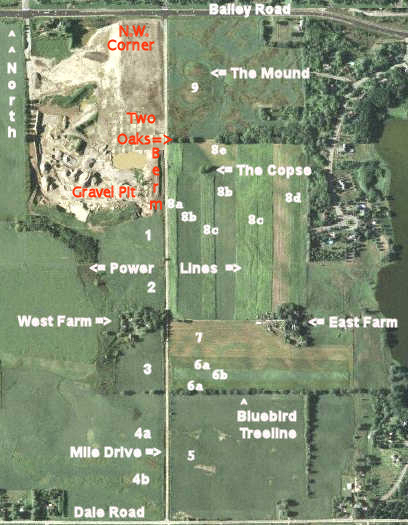
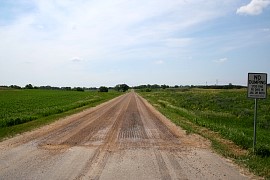 Looking south just starting to walk down Mile Drive - the county road crew has been here and applied
liquid dust control on the road. Counties used to use used motor oil (overuse of the word use), but that was judged by
the federal government and mother earth to be unkind.
Looking south just starting to walk down Mile Drive - the county road crew has been here and applied
liquid dust control on the road. Counties used to use used motor oil (overuse of the word use), but that was judged by
the federal government and mother earth to be unkind.
|
 I walked across the field to The Mound to take a picture of corn growing in field #9 toward
Two Oaks.
I walked across the field to The Mound to take a picture of corn growing in field #9 toward
Two Oaks.
|
|
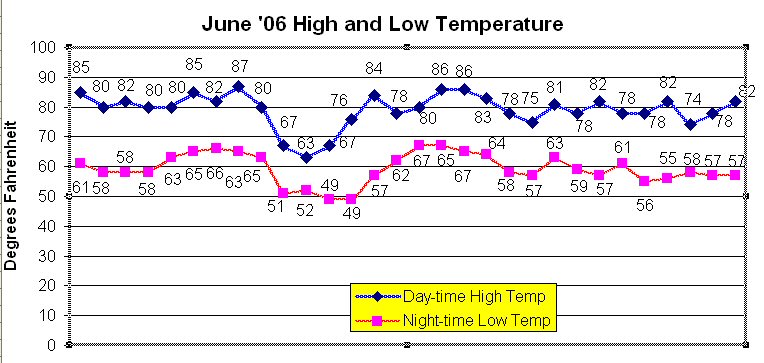
|
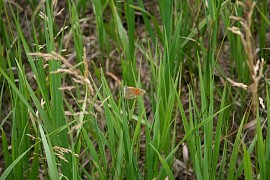
Common Ringlet (Coenonympha tullia) butterfly.
The Common Ringlet is one of the most widespread butterflies in the Northern Hemisphere,
occurring in Eurasia as well as North America. It can be extraordinarily abundant within
its chosen habitats.
|

This butterflies are European Skippers
(Thymelicus lineola). This species is single brooded and flies from early June through late July.
This skipper was introduced accidently to North America in 1910 through London, Ontario.
The Eastern population ranges from Newfoundland west to eastern North Dakota.
|


Narrow-Leaved Hawkweed (Hieracium umbellatum). This is very similar to Narrow-leaved Hawk's Beard,
the difference is that Narrow-Leaved Hawkweed (pictured here) the flower heads all extend from a
single point.
Return to Flora
|



|

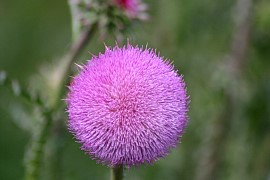
These five shots are all Nodding Thistle, Carduus nutans, also called Musk Thistle. Livestock won't
graze near it, so over time it can take over 100% of a pasture.
Flower heads will droop to a 90-degree angle from the stem when mature and bob in the wind, hence
nodding thistle. Its native to Europe and Asia. Return to Flora
|


 Yellow sweet-cloverMelilotus officinalis) is a member of the pea family.
It was brought to the United States in the 1600s as a forage crop for livestock and for honey
production. It is also often used solely for bee pasture.
It is now found in all 50 states and are used as a soil builder because of it's
nitrogen fixing capability. Return to Flora
Yellow sweet-cloverMelilotus officinalis) is a member of the pea family.
It was brought to the United States in the 1600s as a forage crop for livestock and for honey
production. It is also often used solely for bee pasture.
It is now found in all 50 states and are used as a soil builder because of it's
nitrogen fixing capability. Return to Flora
|
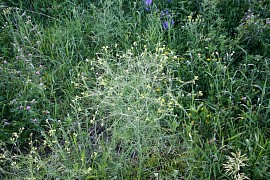

 Wild radish (Raphanus raphanistrum), also called jointed charlock. It's from Europe and Aisa.
Return to Flora
Wild radish (Raphanus raphanistrum), also called jointed charlock. It's from Europe and Aisa.
Return to Flora
|


This is sulphur cinquefoil (Potentilla recta) - I am basing this identification on the
sawtooth leaves. Rough cinquefoil would have notches in the flower petals.
Return to Flora
|
|
|


 Pink peonies, of the genus Paeonia, are among the most dramatic and beautiful flowers for gardens.
Garden peonies will usually begin blooming within three years after planting. The Bailey nursery
grows flowers in scattered plots around this part of Washington county - perhaps these plants
have escaped. Return to Flora
Pink peonies, of the genus Paeonia, are among the most dramatic and beautiful flowers for gardens.
Garden peonies will usually begin blooming within three years after planting. The Bailey nursery
grows flowers in scattered plots around this part of Washington county - perhaps these plants
have escaped. Return to Flora
|
|
That's my guess for why
these peonies are here along the ditch of Dale Road just around the corner from Mile Drive.
I saw them in the distance and
their size and beauty attracted me. As you see in the top-right photo, they attracted someone
else, who came by and dug them up.
|

Here is field #1 with the Round-Up-ready (Round up is a brand of herbicide) soybeans. You can see
the dying broadleaf plants. The plan is that the herbicide-resistant soybean seed will still
germinate.
|

This is not a very good picture of an American Goldfinch (Carduelis tristisis). The camera has
focused on the bark of the tree in the background, and the resolution of the bird is not very good.
I see goldfinches often. Return to Birds
|


Eastern Cottontail (Sylvilagus Floridanus)
Rabbits are not rodents but belong to their own order called lagomorphs.
Cottontails may live to two years in the wild, but where predators are numerous, they seldom
live more than one. 85% of the rabbit population dies each year.
The picture on the right clearly shows the cottontail.
Return to Animals
|


 Western Goat's-Beard (Tragopogon dubius). Just like its smaller relative the dandelion its
long taproots can be dug up, ground, roasted, and used as a coffee substitute. These pictures show
the initial yellow flower and the "goats beard" it turns into. Return to Flora
Western Goat's-Beard (Tragopogon dubius). Just like its smaller relative the dandelion its
long taproots can be dug up, ground, roasted, and used as a coffee substitute. These pictures show
the initial yellow flower and the "goats beard" it turns into. Return to Flora
|

Black Raspberries (Rubus occidentalis) ripen in July. Black raspberries’ unripe fruit is
first bright red, later turning
black and edible. Blackberries are native throughout Eurasia and the Americas. I will have more
pictures of black raspberries - most of these plants will be destroyed when the berm along the
gravel pit is leveled.
|